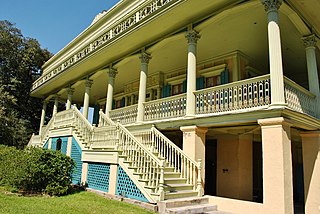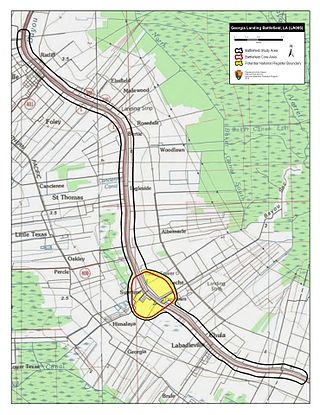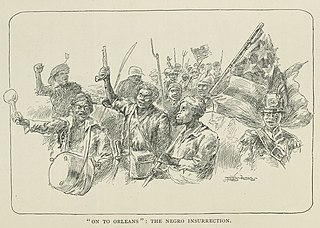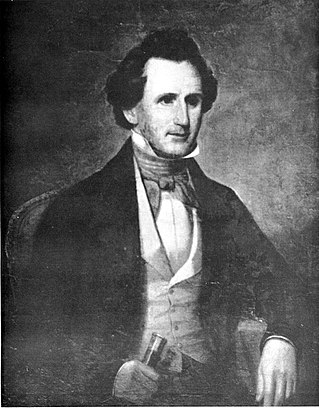River Road African American Museum is a museum of culture and history in Donaldsonville, Louisiana, United States. Founded in 1994, it was among the first Louisiana museums to tell the story of Africans and African Americans, both slave and free. The museum notes their contributions to the River Road region, both before and after the American Civil War. Because of its significance, the museum was identified as one of the first 26 sites included by the state in 2008 on the Louisiana African American Heritage Trail. [1]
The founder Kathe Hambrick created the African American Museum to celebrate the culture and contributions of African Americans in Louisiana, and to provide a more accurate historic account.
Hambrick began to work on the museum in 1991. Returning to Ascension Parish after years away, she noted that despite the tens of thousands of visitors that area plantations received, few were able to learn anything about the contributions of Africans and African Americans, whether slave or free. As late as the 1990s, after academic historians had been writing for more than a generation about black history and social histories, few of the plantations provided the histories of African Americans in the region, either before or after the Civil War. People of African descent had a 300-year history in the region and had contributed significantly to its economy and culture. In addition, many worked on the plantations that had continued to operate into the 20th century.
Hambrick originally established the museum in 1994 at notable Tezcuco Plantation. After it suffered a damaging fire in 2002, the plantation owners decided against rebuilding, and Hambrick had to find a new plantation house .
She relocated the River Road African American Museum to Donaldsonville, about 70 miles from New Orleans. The city has had a strong association with black history. In 1868 the city had elected Pierre Caliste Landry, an attorney and Methodist minister, as the first African-American mayor in the United States. [2] Numerous slaves had escaped there to Union lines, and some fought with Union soldiers in the 1863 defense of Fort Butler. It is now listed on the National Register of Historic Places. After the war, freedmen left rural areas for Donaldsonville to gather in community and establish trades and businesses; it had the third-largest black population of any city in the state.
Hambrick was able to relocate buildings to the site which have historic significance in area history: the first black elementary school in Ascension Parish, the meeting house of an early African-American insurance agency, and the African Plantation house, owned by the first African-American doctor in the parish. [3]
The museum has developed exhibits about black inventors, jazz musicians, and community and political leaders from the area. Another exhibit was about the free people of color in the parish, developed from census and town records. The museum has a strong collection of artifacts and memorabilia from plantations along the River Road from New Orleans; some donated by the plantations; other material donated by individuals from their own families. It also hosts traveling exhibits from other venues, frequent educational programs and workshops in culture.

St. John the Baptist Parish is a parish located in the U.S. state of Louisiana. At the 2020 census, the population was 42,477. The parish seat is Edgard, an unincorporated area, and the largest city is LaPlace, which is also unincorporated.

Ascension Parish is a parish located in the U.S. state of Louisiana. As of the 2020 census, the population was 126,500. Its parish seat is Donaldsonville. The parish was created in 1807. Ascension Parish is part of the Baton Rouge metropolitan statistical area.

Donaldsonville is a city in, and the parish seat of Ascension Parish in the U.S. state of Louisiana. Located along the River Road of the west bank of the Mississippi River, it is a part of the Baton Rouge metropolitan statistical area. At the 2020 U.S. census, it had a population of 6,695.

Acadiana, also known as the Cajun Country, is the official name given to the French Louisiana region that has historically contained much of the state's Francophone population.

Louisiana Creoles are a Louisiana French ethnic group descended from the inhabitants of colonial Louisiana before it became a part of the United States during the period of both French and Spanish rule. They share cultural ties such as the traditional use of the French, Spanish, and Creole languages and predominant practice of Catholicism.

Henry S. Johnson was an American attorney and politician who served as the fifth Governor of Louisiana (1824–1828). He also served as a United States representative and as a United States senator. He participated in the slave trade in the United States.

Laura Plantation is a restored historic Louisiana Creole plantation on the west bank of the Mississippi River near Vacherie, Louisiana, (U.S.), open for guided tours. Formerly known as Duparc Plantation, it is significant for its early 19th-century Créole-style raised big house and several surviving outbuildings, including two slave cabins. It is one of only 15 plantation complexes in Louisiana with this many complete structures. Because of its historical importance, the plantation is on the National Register of Historic Places. The site, in St. James Parish, Louisiana, is also included on the Louisiana African American Heritage Trail.

The Battle of Georgia Landing or Battle of Labadieville was fought between a Union Army force led by Brigadier General Godfrey Weitzel and a Confederate States Army force commanded by Brigadier General Alfred Mouton near Labadieville, Assumption Parish, Louisiana, during the American Civil War. After a sharp clash, the Union troops compelled Mouton's outnumbered force to retreat.

St. Augustine Church is a Catholic parish in New Orleans. Established by free people of color, who also bought pews for slaves, it is said to be the oldest Black Catholic parish in the United States, established in 1841. It was one of the first 26 sites designated on the state's Louisiana African American Heritage Trail.

Louisiana African American Heritage Trail is a cultural heritage trail with 38 sites designated by the state of Louisiana, from New Orleans along the Mississippi River to Baton Rouge and Shreveport, with sites in small towns and plantations also included. In New Orleans several sites are within a walking area. Auto travel is required to reach sites outside the city.

St. Augustine Catholic Church and Cemetery, or the Isle Brevelle Church, is a historic Catholic parish property founded in 1829 near Melrose, Natchitoches Parish, Louisiana. It is the cultural center of the Cane River area's historic French, Spanish, Native American and Black Creole community. It is also the oldest surviving Black Catholic church in the United States.

The 1811 German Coast uprising was a revolt of slaves in parts of the Territory of Orleans on January 8–10, 1811. The uprising occurred on the east bank of the Mississippi River in what is now St. John the Baptist, St. Charles and Jefferson Parishes, Louisiana. The slave insurgency was the largest in U.S. history, but the rebels killed only two White men. Confrontations with militia, combined with post-trial executions, resulted in the deaths of 95 enslaved people.

Ashland Plantation, also known as the Belle Helene or Ashland-Belle Helene Plantation, is a historic building, built in 1841, that was a plantation estate and home of Duncan Farrar Kenner. Located in Darrow, Louisiana, in Ascension Parish. The manor house is an example of antebellum Greek Revival architecture.

Pierre Caliste Landry was born into slavery and went on to become an attorney, Methodist Episcopal minister, mayor, newspaper editor, and state legislator in Louisiana. He was elected in 1868 as mayor of Donaldsonville, making him the first African American to be elected mayor in the United States.

Bocage Plantation is a historic plantation in Darrow, Ascension Parish, Louisiana, about 25 miles (40 km) southeast of Baton Rouge. The plantation house was constructed in 1837 in Greek Revival style with Creole influences, especially in the floorplan. Established in 1801, the plantation was added to the National Register of Historic Places on June 20, 1991.
Trasimond Landry was an American politician. Between 1846 and 1850 he served as Lieutenant Governor of Louisiana.

Robert Ruffin Barrow was one of the largest landowners and slave owner in the south before the American Civil War. He owned sixteen plantations, mostly in Louisiana, and had large landholdings in Texas. He also invested money in projects in which he saw potential. The most well known investment he made was in the early submarine projects of his brother-in-law, Horace Hunley, for the Confederate States Navy.
The Rural African American Museum is a museum in Opelousas that focuses on the history of African Americans living in St. Landry Parish, Louisiana, United States, from the American Civil War to the present. It was inaugurated in late 2018 and is free to tour, although its operations rely primarily on donations. The museum's creator and president is Wilken Jones, a retired social studies school teacher who grew up in the nearby town of Plaisance. The permanent exposition showcases books, objects and press clippings that pertain to the economic, religious and political history of the region. The items on display include antique bedroom furniture, kitchen utensils and farm tools, among other things. The exposition illustrates the conditions of life of many Black sharecroppers in the late 19th and early 20th century.
Modeste, Louisiana is an unincorporated village in Ascension, Parish, Louisiana. The community is located along the Mississippi River on Louisiana Highway 405, north of the parish seat of Donaldsonville, between Hohen Solms, and Philadelphia Point, due south and across the river from Geismar.